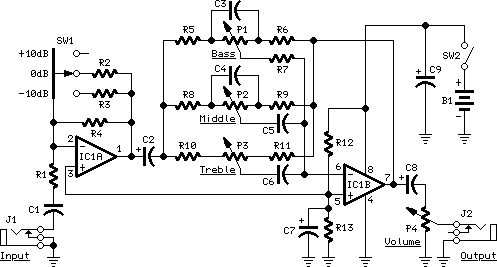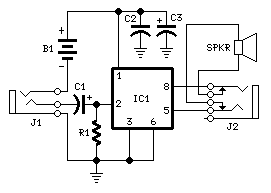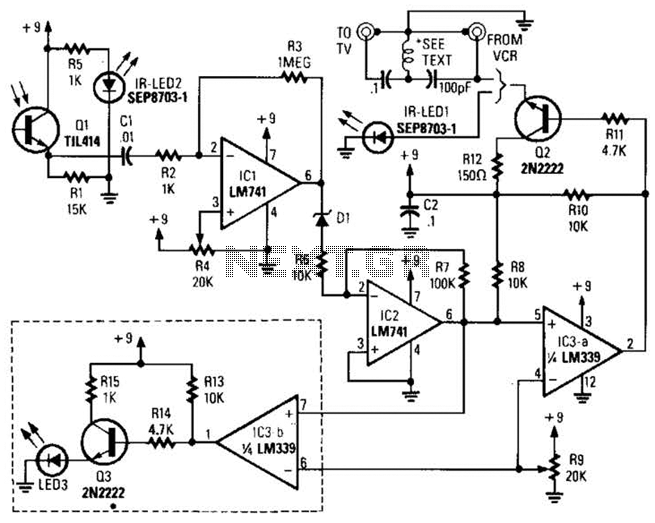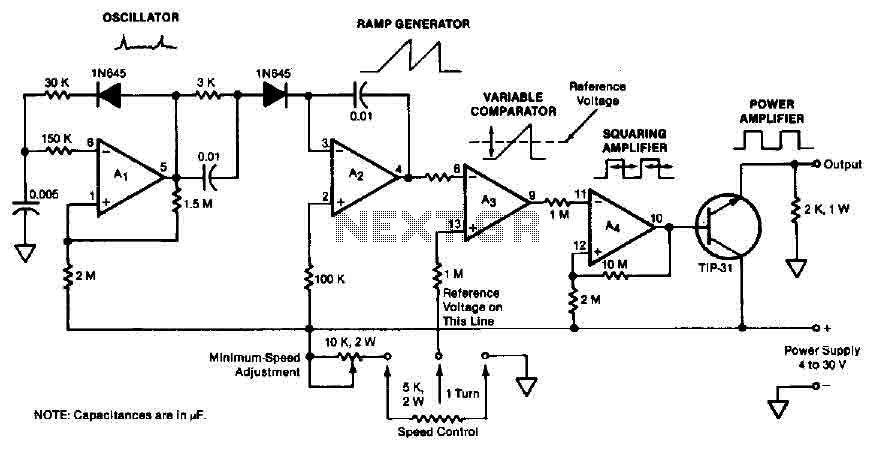
Guitar Control

The IC1A operational amplifier is configured as an inverting amplifier, with its gain determined by a three-way switch that connects different resistor values in parallel to R4. Following this input stage is an active three-band tone control circuit, designed to maintain unity gain when the controls are positioned at their center setting, and is constructed using IC1B.
The circuit described involves two primary stages: an inverting amplifier stage and a tone control stage. The inverting amplifier, utilizing IC1A, operates by applying an input signal to the inverting terminal while the non-inverting terminal is grounded. The gain of this amplifier is adjustable through a three-way switch, which allows for the selection of different resistor values that are connected in parallel with R4. By changing the resistance, the overall feedback factor of the amplifier is altered, thus varying the gain according to the selected resistor.
In the subsequent tone control stage, IC1B is employed to implement a three-band equalizer. This stage is designed to modify the frequency response of the audio signal, allowing for adjustments in bass, midrange, and treble frequencies. The tone controls are typically configured as potentiometers that can boost or cut the selected frequency bands. At the center position of these controls, the circuit is designed to achieve a flat frequency response, ensuring that the output signal remains faithful to the input without any tonal coloration.
The integration of these two stages allows for a versatile audio processing circuit that can enhance sound quality according to user preferences. The inverting amplifier provides the necessary signal conditioning, while the tone control stage offers flexibility in adjusting the audio characteristics. Overall, this configuration is commonly used in audio applications where precise control over the sound output is desired.IC1A op-amp is wired as an inverting amplifier, having its gain set by a three ways switch inserting different value resistors in parallel to R4. This input stage is followed by an active three-band tone control stage having unity gain when controls are set in their center position and built around IC1B.
🔗 External reference
The circuit described involves two primary stages: an inverting amplifier stage and a tone control stage. The inverting amplifier, utilizing IC1A, operates by applying an input signal to the inverting terminal while the non-inverting terminal is grounded. The gain of this amplifier is adjustable through a three-way switch, which allows for the selection of different resistor values that are connected in parallel with R4. By changing the resistance, the overall feedback factor of the amplifier is altered, thus varying the gain according to the selected resistor.
In the subsequent tone control stage, IC1B is employed to implement a three-band equalizer. This stage is designed to modify the frequency response of the audio signal, allowing for adjustments in bass, midrange, and treble frequencies. The tone controls are typically configured as potentiometers that can boost or cut the selected frequency bands. At the center position of these controls, the circuit is designed to achieve a flat frequency response, ensuring that the output signal remains faithful to the input without any tonal coloration.
The integration of these two stages allows for a versatile audio processing circuit that can enhance sound quality according to user preferences. The inverting amplifier provides the necessary signal conditioning, while the tone control stage offers flexibility in adjusting the audio characteristics. Overall, this configuration is commonly used in audio applications where precise control over the sound output is desired.IC1A op-amp is wired as an inverting amplifier, having its gain set by a three ways switch inserting different value resistors in parallel to R4. This input stage is followed by an active three-band tone control stage having unity gain when controls are set in their center position and built around IC1B.
🔗 External reference





